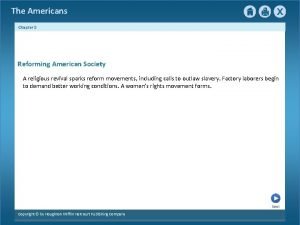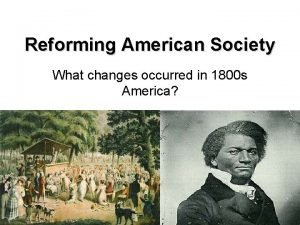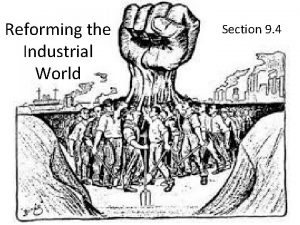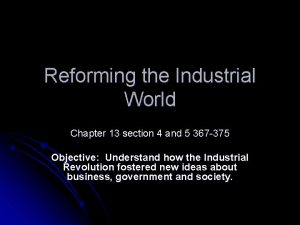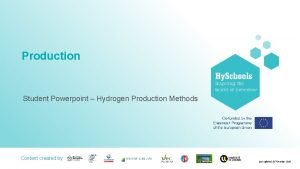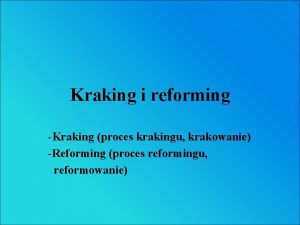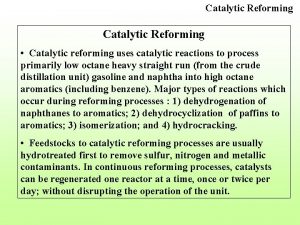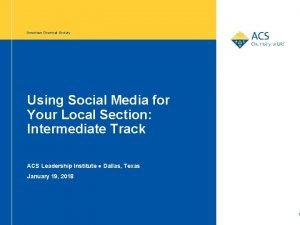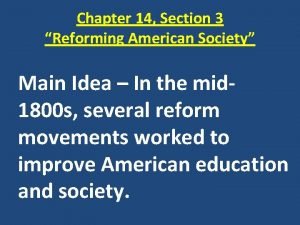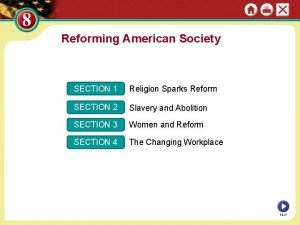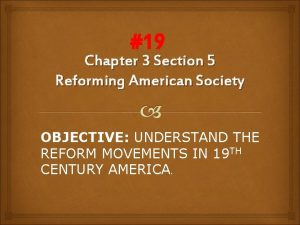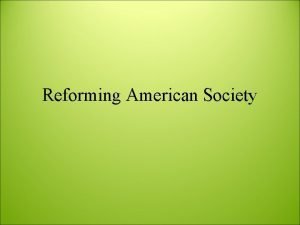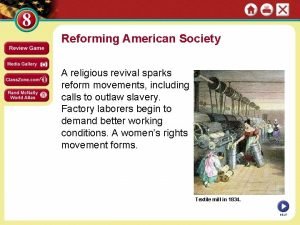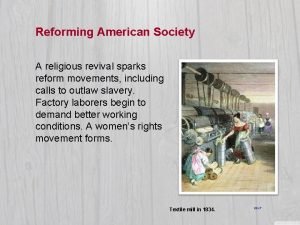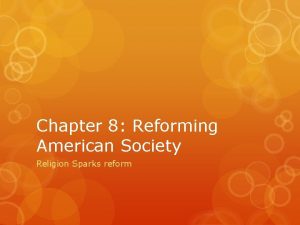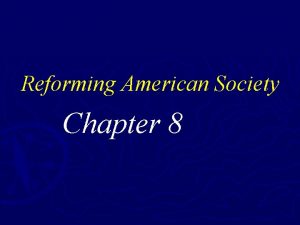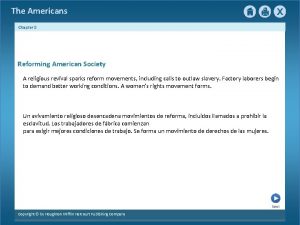Ch 8 Reforming American Society Section 1 The
















- Slides: 16

Ch. 8 Reforming American Society

Section 1 The Second Great Awakening Reaction to Rationalism (belief in human reasoning) • Preach in easy to understand sermon • Individual responsibility for salvation

Examples of Religious Reform • Revivalism in New York- Presbyterian minister: Charles G. Finney. Appealed to emotions instead of rational (damnation) -Saved through faith and hard work Shakers- Believed in celibacy. Believed in equality among women and men Did not believe in fighting for any reason.

Culture: Ideas • Transcendentalists- Discovery of one’s inner self and looking for the essence of God in nature. • Challenged capitalism • Challenged Established churches

Transcendentalists • Ralph Waldo Emerson -Spoke on making our own American culture -Argued for- Self-reliance, independent thinking, spiritual matters over material, opposed slavery. • Henry David Thoreau- Two- year experiment in the woods. Wrote the book Walden. -Essay “On Civil Disobedience” – Non-violent protest.

Brook Farm (Vision of Utopia) • Attempt to live out transcendentalism • George Ripley (Protestant minister) • Experiment at Brook Farm in Massachusetts. • Many writers came to the farm for artistic creativity and schooling

Major Reforms Asylums and Prisons -Dorothy Dix- Help keep mentally ill out of jail. Education • Free common schools- Horace Mann led the charge for free public schools. Attendance requirement, Longer school year, and increased teacher preparation.

Section 2 Slavery and Abolition • Abolition- Outlaw slavery • William Lloyd Garrison- Radical white abolitionist. Created a paper called the Liberator calling for immediate freedom for slave based on morality. • David Walker- Free black, called for violent and active fighting for freedom by slaves. • Fredrick Douglass- Was a slave but ran away. Began his own newspaper called the North Star to help the political anti-slavery movement.

Slavery Rebellions Uprisings: - Charlestown- Denmark Vesey in 1822 -Virginia- Nat Turner in 1831 - Killed 60 whites • Quickly put down • Gave hope to slaves • Tightened slave codes. *Virginia Debate- Vote for abolition, loses 73 -58 Gag Rule- Limited debate on an issue by citizens.

Varieties of slavery Establish slave codes Slaves could not… -hold property -leave master’s premises without permission -be out after dark -carry firearm -congregate except for church -strike a white person, even in self-defense -learn to read or write -testify in court against whites -marry or divorce Enforcement was inconsistent

Section 3 Women and Reform • View of women in the mid-1800’s -Cult of Domesticity- Women do housework and tend to the children.

Reform • Sarah and Angelina Grimke- Spoke for abolition • Sojourner Truth- Abolition and women's rights. • Temperance Movement- Prohibit drinking of alcohol. Led to the formation of the American Temperance Society • Women education and health care improved

Seneca Falls Convention • 1848, New York- Elizabeth Cady Stanton and Lucretia Mott held a women’s rights convention. • Wrote Declaration of Sentiments- Grievances for women’s rights and equality with men. • Inspired by? ? ?

Section 4 Changing Workplace • More women leaving the farm and working in textile mills • Shift from making things at home to factories • Lowell Mill- Unmarried women usually worked for low wages at these mills • Working conditions went from good to bad. WHY? • Led to strikes

Unions • National Trades’ Unions – Large collaboration of different individual unions • Supreme Court Case- Commonwealth v. Hunt • Decides unions and peaceful strikes are ok. • Unions still very ineffective

Increased Immigration Reasons for growth: • Strong Agriculture economy • Germans and Irish come -Irish: Potato famine -Germans: Economic dislocations
 Chapter 8 reforming american society
Chapter 8 reforming american society Reforming american society
Reforming american society Chapter 9 section 4 reforming the industrial world
Chapter 9 section 4 reforming the industrial world Chapter 25 section 4 reforming the industrial world
Chapter 25 section 4 reforming the industrial world Chapter 9 section 4 reforming the industrial world
Chapter 9 section 4 reforming the industrial world Chapter 9 section 4 reforming the industrial world
Chapter 9 section 4 reforming the industrial world Chapter 9 section 4 reforming the industrial world
Chapter 9 section 4 reforming the industrial world Bottleneck reaction
Bottleneck reaction Reforming the industrial world
Reforming the industrial world Steam methane reforming ppt
Steam methane reforming ppt Krakowanie
Krakowanie Catalytic reforming of hexane
Catalytic reforming of hexane Gertler econ
Gertler econ American society for industrial security
American society for industrial security American fisheries society certification
American fisheries society certification American chemical society
American chemical society American society of hematology
American society of hematology
